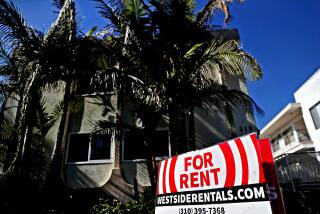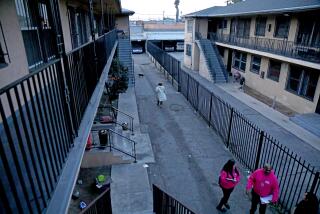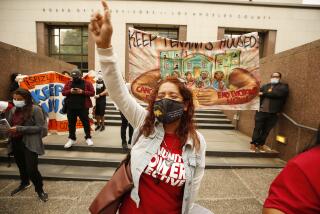California set to extend eviction protections, pay 100% of back rent

Protections for tenants who pay at least 25% of their rent expire Wednesday, but the Legislature will likely OK an extension as early as Monday.
SACRAMENTO — With California’s tenant protections against evictions expiring next week, Gov. Gavin Newsom and legislative leaders agreed Friday to extend them until Sept. 30 and to cover 100% of the back rent owed by many low-income residents whose finances were hurt by the COVID-19 pandemic.
The state protections for tenants who pay at least 25% of their rent are set to expire Wednesday, but the agreement between Newsom and the leaders of the state Senate and Assembly makes it likely the Legislature will give the required approval of the three-month extension as early as Monday.
Providing more time will also allow distribution of hundreds of millions of dollars in rental assistance that has gone unclaimed since it was offered in March.
Senate President Pro Tem Toni Atkins (D-San Diego), a lead negotiator on the agreement, said the proposal is aimed at averting mass evictions.
“Our housing situation in California was a crisis before COVID, and the pandemic has only made it worse — this extension is key to making sure that more people don’t lose the safety net helping them keep their home,” Atkins said in a statement.
The governor said that without the extension, many low-income people face eviction even though the economy is recovering.
The proposal, Newsom said, is “protecting low-income tenants with a longer eviction moratorium and paying down their back rent and utility bills — all thanks to the nation’s largest and most comprehensive rental assistance package, which I am eager to sign into law as soon as I receive it.”
Tenant advocates say it is essential that the Legislature approve the extension before Wednesday’s expiration of the current eviction protections and expand the rent relief program to give a clean slate to renters who are deep in debt.
“That would provide a real sense of relief for a lot of folks who have been struggling to pay the rent and who are facing the reality that in about a week they, absent actions by the Legislature, would be facing eviction when the July rent comes due,” said Brian Augusta, legislative advocate for the California Rural Legal Assistance Foundation, which represents low-income tenants.
Augusta said he would have liked to have seen a longer extension, noting there are still questions about what would happen if all of the rent relief is not distributed by Sept. 30 or if the fund is depleted before all tenants in need have 100% of their back rent paid.
In January, the governor and Legislature approved $2.6 billion in rental assistance for low-income tenants as well as a law that blocks eviction of tenants through June 30 as long as they pay at least 25% of their rent. The state and local governments have divided the money among them.
But the state has sent out only $61.6 million of the $1.4-billion share that it is distributing — less than 5% — to 5,442 applicants, and landlords and tenants had applied for only about half of the money as of Thursday.
Some counties are also having a hard time getting out the $1.2 billion in relief that the state provided to local agencies for distribution.
About 758,000 California households are behind on rent, with the amount owed averaging $4,700, according to research by PolicyLink and the USC Equity Research Institute.
Rental assistance under the state program is available to tenants whose household income is at or below 80% of the area median income as set by the federal government and who have declared a pandemic-related economic hardship. Immigrants in the country illegally are eligible.
For a family of four in Los Angeles County outside the city of Los Angeles, the equivalent of 80% of median income is $94,600.
To make it easier for more people to get rental assistance, the proposed legislation would allow tenants and landlords who already received partial reimbursement to get the new 100% reimbursement automatically, without the need to reapply.
If landlords refuse to participate in the rental assistance program, the proposal would still allow checks to be issued directly to the tenants to cover back rent.
In addition, rental assistance may be paid where rent is owed even if the tenant has left the premises.
When evictions can resume Oct. 1, a new court process will be put in place that gives tenants an opportunity to apply for rental assistance before a landlord can force an eviction. If the assistance application is approved, an eviction will not be allowed.
However, if a tenant is not eligible for rental assistance or doesn’t apply, a landlord would be able to pursue the eviction.
The new court process would last until March 31, 2022.
Landlords are concerned that this would be the fourth extension of the eviction protections, with many of them having not received full rent for more than a year.
Newsom originally signed an executive order barring evictions in March 2020, at the beginning of the COVID-19 pandemic, when a state stay-at-home order meant many people could not go to work to earn money for their rent. The Legislature and governor extended the eviction protections in August 2020.
The California Apartment Assn. is “disappointed” that the protections will be extended, Chief Executive Tom Bannon said Friday.
The extension would not be necessary, he said, “if state and local governments were disbursing rental assistance funds to tenants and housing providers in an expedited manner.”
“It is frustrating that the state of California and numerous local governments have not quickly disbursed funds to those in need, especially to mom-and-pop rental housing providers who have not seen any rent payments yet must still pay the mortgage, insurance, taxes, maintenance and other expenses,” he added.
Other government agencies have also taken action this week. The Los Angeles County Board of Supervisors agreed on Tuesday to extend the county’s eviction moratorium through the end of September.
A separate eviction moratorium implemented by the city of Los Angeles will remain in place until Mayor Eric Garcetti lifts the city’s public health emergency declaration.
In addition, the Biden administration this week extended a national moratorium on evictions until July 31.
L.A. County leaders have complained that the county is not receiving the funding it needs to meet demand from very low-income people, while other parts of the state with smaller populations are getting more than they need.
The state has the authority to reallocate unused funds to jurisdictions that have demonstrated unmet needs, said Russ Heimerich, spokesman for the Business, Consumer Services and Housing Agency.
In addition, he noted that the rent relief program gives priority to households that are below 50% of area median income.
Los Angeles County officials were still reviewing the bill but appreciate the Legislature including direction in the legislation for the state housing agency to base allocation on need, said Elisa Vasquez, a spokeswoman for the L.A. County Development Authority.
“We look forward to working with that agency on ensuring the needs are met,” she said.
Many tenants across the state have been anxious as negotiations continued behind closed doors in Sacramento about extending the state protections against evictions and expanding rental assistance to tenants.
Not knowing in recent weeks whether there would be relief has caused significant anxiety for tenants such as Lori Kolstad, who owes about $13,000 in back rent for her family’s Vacaville home.
“It’s just a really scary thought right now of really being out on the street,” said Kolstad, who worked in clothing production before the business shut down last year because of the pandemic.
Kolstad said Wednesday that she has been paying about half her rent when she could but worries she could face eviction unless the Legislature approves a relief program.
“It would be a huge help,” Kolstad said. “It would take tons of pressure off.”
Under the current state law, if landlords waive 20% of back rent owed, the state would reimburse them for 80% of an eligible tenant’s unpaid rent going back to April 1, 2020. Renters whose landlords choose not to participate in the program may apply on their own and receive 25% of unpaid rent.
However, landlords and tenants have not applied in sufficient numbers under the old funding, with tenant advocates saying that the paperwork is complicated and that some landlords are not cooperating, which discourages many tenants who would get only 25% of back rent paid if the landlord does not participate.
The proposal released by legislative leaders and the governor would increase the money available for rental assistance to $5.2 billion, which would pay 100% of back rent owed by many low-income tenants as well as rent for some future months as money lasts.
State officials think more landlords and tenants will apply for the rental assistance if it covers all of the rent owed as well as rent for future months as money is available.
Assembly Republican leader Marie Waldron of Escondido said the proposal is a “temporary fix” because the state surplus and recovery money from the federal government are not permanent.
“This needs to be the final extension because forcing landlords to forgo collecting rent with the state paying for back rent is not a permanent solution,” she said.
Augusta said the low-income tenants his group represents would welcome the chance to have all their back rent paid, and he worries that rental assistance money will go undistributed if evictions are allowed to resume too soon.
“It would be a travesty to let evictions turn back on with that money sitting in the bank,” Augusta said. “It would be enormous to get some extension and some breathing room while we try to improve how we get the money out.”
More to Read
Sign up for Essential California
The most important California stories and recommendations in your inbox every morning.
You may occasionally receive promotional content from the Los Angeles Times.











